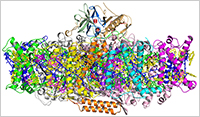Enlarge Image
Exploring the structural basis for high-efficiency energy transfer in photosynthetic organisms
Photosystem I (PSI) is one of the two photosystems found in the thylakoid membrane of oxygenic photosynthetic organisms. Its function is to harvest light energy that is utilized to drive a chain of electron transfer reactions, which leads to the production of the reduction power required for converting CO2 into sugars. In higher plants, the core of PSI is surrounded by a large light-harvesting complex I (LHCI), which forms a PSI-LHCI supercomplex with a total molecular mass of 600 kDa. The light energy captured by LHCI is transferred to the PSI core with an extremely high efficiency.
The crystal structure of plant PSI-LHCI supercomplex has been reported previously. However, the crystal structures reported so far lacked sufficient resolution to reveal the detailed organization of the PSI-LHCI supercomplex with atomic precision, especially with respect to the positions and number of cofactors associated with LHCI.
Now, Michi Suga, Jian-Ren Shen at Okayama University in collaboration with Tingyun Kuang and Xiaochun Qin at the Chinese Academy of Sciences have solved the crystal structure of plant PSI-LHCI supercomplex to a resolution of 2.8 Å.
The research group purified and crystallized the PSI-LHCI supercomplex from the leaves of a pea plant and succeeded in improving the quality of the crystals dramatically. With these improved crystals the group was able to collect the X-ray diffraction data using the intense X-ray at the synchrotron facility SPring-8 in Japan. They then analysed the data using crystallographic approaches to determine the structure.
The improved structure revealed the detailed organization of protein subunits and cofactors. This enabled the mechanisms of energy transfer, regulation, and photoprotection within the PSI-LHCI supercomplex to be examined on a more robust structural basis.
This work provides structural insights into the energy absorption and transfer mechanisms in photosynthesis. In addition it may provide a blueprint for the design of light-harvesting setups with extremely high efficiencies that can be utilized in artificial photosynthetic systems.
Reference:
・ Authors: Xiaochun Qin1,2, Michihiro Suga1, Tingyun Kuang2 and Jian-Ren Shen1,2
・ Title of original paper: Structural basis for energy transfer pathways in the plant PSI-LHCI supercomplex.
・ Journal, volume, pages and year: Science 348, 989 (2015).
・ Digital Object Identifier (DOI): 10.1126/science.aab0214
・ Journal website: http://www.sciencemag.org/content/348/6238/989.full
・ Affiliations: 1Photosynthesis Research Center, Graduate School of Natural Science and Technology, Okayama University; 2Institute of Botany, Chinese Academy of Sciences
・ Department website: http://www.gnst.okayama-u.ac.jp/index_e.html

